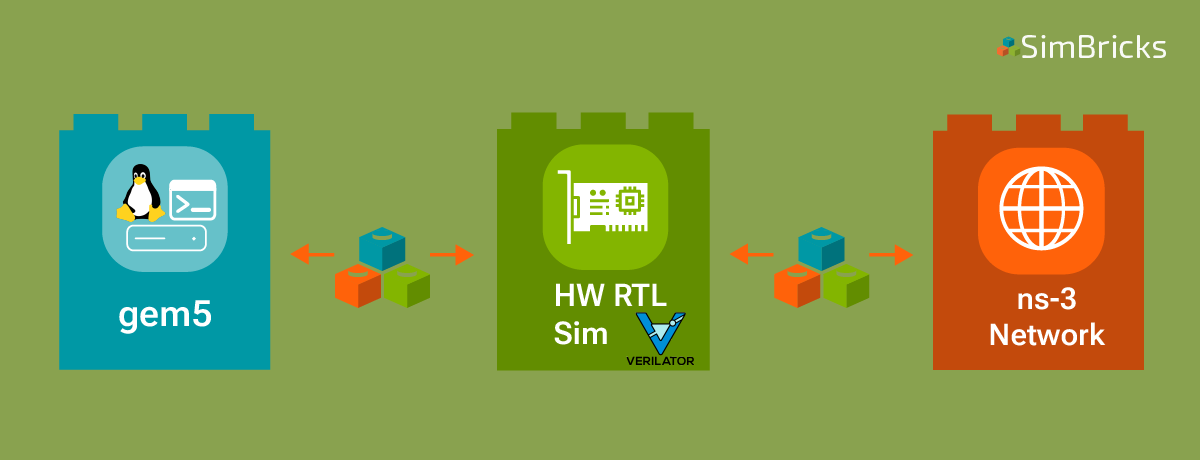In today’s blog post we explore how SimBricks can help accelerate the design, implementation, and validation of chips for modern computer systems. Custom chips tailored to specific tasks offer significant performance gains and lower power consumption compared to general-purpose processors, but building them is an expensive and slow process. They are widely used from data centers to everyday devices, and are typically a small part of a larger system of many components. SimBricks provides early and continuous feedback throughout the process by enabling true full simulations, thereby accelerating the process.
Specification and Architectural Design
SimBricks shines already in the early stages of chip design, where system and hardware architects define core functionality and break down the overall system into manageable blocks. SimBricks can simulate connected hardware and software components of the complete system to support early design activities.
Full-System Architecture Exploration
Architectural choices in the new chip often substantially affect overall system performance. Instead of only relying on analytical system models that are likely to miss details significantly affecting system performance, SimBricks enables system architects to do architectural exploration with reliable full-system results, by integrating high-level SystemC models for the new chip with existing simulators for the remaining system components. This integration only requires adding lightweight adapter components to the SystemC model. For example, a SystemC model could integrate with attached machines (e.g. simulated by QEMU, gem5, Simics), running Linux and real applications, other attached hardware components (e.g. NICs, SSDs), or the network itself (e.g. simulated by ns3, OMNeT++).
Hardware-Software Co-Design
Modern computer systems rely on closely integrated hardware and software components which ideally should be designed together. SimBricks enables system architects to explore design choices in both hardware and software as well as their interaction, as the simulations include processors and other components running software.
Virtual Platform for Software Development
These systems also require substantial software development effort, however many software components are difficult to test before hardware is available. SimBricks can provide virtual platforms to speed-up software development and enable early integration testing, enabling parallel software and hardware development at the earliest stages. This is also particularly useful for developing components at the boundaries such as device drivers.
RTL Implementation and Verification

SimBricks continues to add value beyond the early design stages by integrating RTL simulation into full systems. RTL simulators such as Verilator or Vivado xsim, can integrate into full system simulations similar to the SystemC models earlier. Generally this requires some minimal design-specic adapters to connect wires on the top-level module through the SimBricks component interface. To make this easier, SimBricks already provides a few reusable building blocks, such as different AXI adapters. This helps streamline RTL implementation.
End-to-End RTL Testing
Instead of only simulating RTL in isolation with testbenches, SimBricks enables continuous integration tests of the RTL implementation into the full system. In addition to enabling early integration tests, this can also substantially reduce time otherwise needed for complex testbench code and help testing the in very complex situations and workloads, which would be prohibitively complex to implement as testbenches.
Early RTL Performance Testing
In addition to functionality, this also enables early performance testing of the RTL within the full system. This helps hardware engineers evaluate the impact of even low-level implementation choices on bottom-line system performance. This helps identify important issues early, and separating them from local performance problems that do not actually impact overall system performance at all.
Post-Synthesis Validation
There are even potential benefits to using SimBricks after synthesis. The starting point here is to integrate gate-level simulators into SimBricks to full system. Just like previous stages, a custom adapter allows seamless integration. This enables validating fully implemented designs in the context of the complete system. Additionally, gate-level simulations as part of a full system can help to obtain more reliable energy and thermal estimations based on real workload characteristics.
Overall our comprehensive full-system simulation approach, powered by SimBricks, leads to a more efficient design process through more reliable and accurate simulation results that can be used to optimize the proposed chip early on. We have some concrete examples of this in our GitHub repositories. Please reach out if you would like to learn more:

 Jakob Görgen
Jakob Görgen




